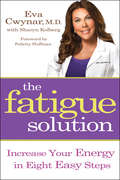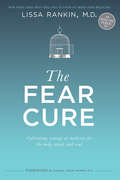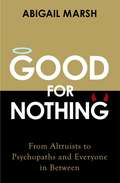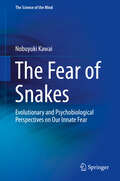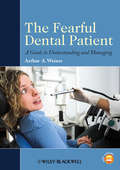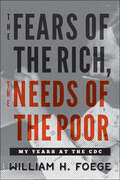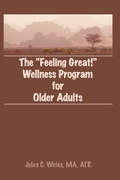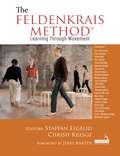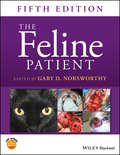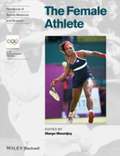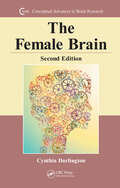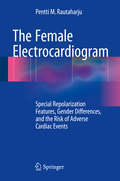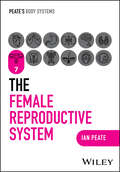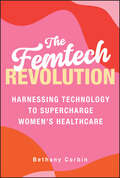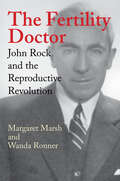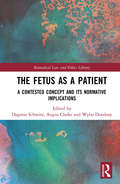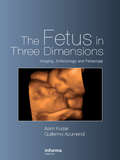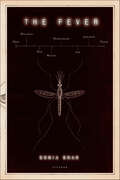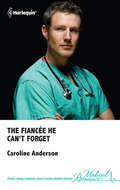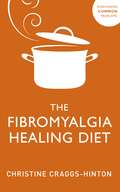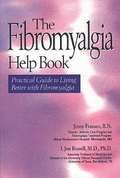- Table View
- List View
The Fatigue Solution: Increase Your Energy In Eight Easy Steps
by Eva CwynarAn emotion common to humankind is fear. Fear dogs our days, makes us lose sleep, ruins our relationships, and takes the joy out of living. The strongest, best defense against that emotion is to see through the eyes of faith. As such, Ben Stein brings you 500 ways to look at life in this way so that you can triumph over fear. Ben absorbed many of the positive thoughts within these pages at 12-Step meetings he has attended, he has applied them to his own life, and he’s found that they work. They’re simple, but extremely effective. For example: I do not know exactly why faith and surrender work. I just know that they do work; Say it to yourself and believe it: My life is a great place to be today. I would rather be me than anyone else, and that’s saying something; Life is about waking up, breaking up, shaking up, making up . . . and meditation to keep the human spirit calm; and there are two forms of worship: worship of God and worship of ourselves. Guess which kind works? Taken regularly, concepts such as these will make your life easier, calmer, and definitely more enjoyable.
The Fear Cure: Cultivating Courage As Medicine For The Body, Mind And Soul
by Lissa RankinNot many people in the medical world are talking about how being afraid can make us sick-but the truth is that fear, left untreated, becomes a serious risk factor for conditions from heart disease to diabetes to cancer. Now Lissa Rankin, M.D., explains why we need to heal ourselves from the fear that puts our health at risk and robs our lives of joy-and shows us how fear can ultimately cure us by opening our eyes to all that needs healing in our lives. Drawing on peer-reviewed studies and powerful true stories, The Fear Cure presents a breakthrough understanding of fear's effects and charts a path back to wellness and wholeness on every level. We learn: How a fearful thought translates into physiological changes that predispose us to illness How to tell true fear (the kind that arises from a genuine threat) from false fear (which triggers stress responses that undermine health) How to tune in to the voice of courage inside-our "Inner Pilot Light" How to reshape our relationship to uncertainty so that it's no longer something to dread, but a doorway to new possibilities What our fears can teach us about who we really are At the intersection of science and spirituality, The Fear Cure identifies the Four Fearful Assumptions that lie at the root of all fears-from the sense that we're alone in the universe to the belief that we can't handle losing what we love-and shifts them into Four Courage-Cultivating Truths that pave our way to not only physical well-being, but profound awakening. Using exercises from a wide range of mind-body practices and spiritual traditions, Dr. Rankin teaches us how to map our own courage-cultivating journey, write a personalized Prescription for Courage, and step into a more authentic life.
The Fear Factor: How One Emotion Connects Altruists, Psychopaths and Everyone In-Between
by Abigail Marsh'A riveting ride through your own brain' - Adam Grant, New York Times bestselling author of OriginalsWINNER of the Society for Personality and Social Psychology's book prize for 'The Promotion of Social and Personality Science'If humans are fundamentally good, why do we engage in acts of great cruelty? If we are evil, why do we sometimes help others at a cost to ourselves? Whether humans are good or evil is a question that has plagued philosophers and scientists for as long as there have been philosophers and scientists.Many argue that we are fundamentally selfish, and only the rules and laws of our societies and our own relentless efforts of will can save us from ourselves. But is this really true? Abigail Marsh is a social neuroscientist who has closely studied the brains of both the worst and the best among us-from children with psychopathic traits whose families live in fear of them, to adult altruists who have given their own kidneys to strangers. Her groundbreaking findings suggest a possibility that is more optimistic than the dominant view. Humans are not good or evil, but are equally (and fundamentally) capable of good and evil.In The Fear Factor Marsh explores the human capacity for caring, drawing on cutting edge research findings from clinical, translational and brain imaging investigations on the nature of empathy, altruism, and aggression and brings us closer to understanding the basis of humans' social nature.'You won't be able to put it down' - Daniel Gilbert, New York Times bestselling author of Stumbling on Happiness'[It] reads like a thriller... One of the most mind-opening books I have read in years' - Matthieu Ricard, author of Altruism
The Fear of Snakes: Evolutionary and Psychobiological Perspectives on Our Innate Fear (The Science of the Mind)
by Nobuyuki KawaiThis book provides a series of compelling evidence that shows that humans have innate fear of snakes. Building on the previous studies on the Snake Detection Theory (SDT), the author presents a summary of psychological and neuropsychological experiments to explain the fear of snakes in humans and primates. Readers will come to understand why and how we are afraid of snakes from an evolutionary perspective.The first half of the book discusses the history of psychological behaviorism and neobehaviorism. The latter half of the book consists mainly of the experimental studies performed by the author with a focus on three key items: First, compared with other animals, snakes especially draw the attention of primates and humans. Second, the ability of primates and humans to recognize snakes with particular efficiency. Third, processing mechanisms within the brain for snake detection is discussed from a new viewpointThe book offers a unique resource for all primatologists, psychologists, neuroscientists, anthropologists, herpetologists, and biologists who are interested in the evolution of visual and cognitive systems, mechanisms of fear, snakes or primates.
The Fearful Dental Patient: A Guide to Understanding and Managing
by Arthur A. WeinerThe Fearful Dental Patient: A Guide to Understanding and Managing helps dental professionals understand the basics of fear, anxiety and phobias and the role these emotions play in creating negative behavior within the dental environment. The text contains a variety of modalities that help identify dental fear and phobia, as well as chair-side techniques and practical advice aimed at improving patient cooperation and ensuring treatment compliance. Chapter topics include the basic origins of patient fear and anxiety, how to indentify dental anxiety and varied approaches to managing fearful patients of any age. Approaches discussed employ behavioral, pharmacological, sedation and even hypnotic techniques, specifying combinations where required. Chapters also include coverage of a wide range of patients, including those with psychiatric comorbidities and special healthcare needs. The entire dental team will greatly benefit from the proven methods and practical guidance presented to better understand and treat fearful dental patients.
The Fears of the Rich, The Needs of the Poor: My Years at the CDC
by William W. FoegeWilliam H. Foege, one of the most respected leaders in global public health, takes readers on a tour of his time at the CDC.In its seventy years, the Centers for Disease Control and Prevention (CDC) has evolved from a malaria control program to an institution dedicated to improving health for all people across the world. The Fears of the Rich, The Needs of the Poor is a revealing account of the CDC’s development by its former director, public health luminary William H. Foege.Dr. Foege tells the stories of pivotal moments in public health, including the eradication of smallpox (made possible due in part to Foege’s research) and the discovery of Legionnaires’ disease, Reye syndrome, toxic shock syndrome, and HIV/AIDS. With good humor and optimism, he recounts the various crises he surmounted, from threats of terrorist attacks to contentious congressional hearings and funding cuts. Highlighting the people who made possible some of public health’s biggest successes, Foege outlines the work required behind the scenes and describes the occasional tensions between professionals in the field and the politicians in charge of oversight. In recent years, global public health initiatives have come from unanticipated sources. Giants in the field now include President Jimmy Carter and his wife, Rosalynn, who promote programs aimed at neglected diseases. Melinda and Bill Gates have invigorated the field through research and direct program support, especially in the area of vaccine-preventable diseases. And the Merck Mectizan program has dramatically reduced river blindness in Africa. Foege has been involved in all of these efforts, among others, and he brings to this book the knowledge and wisdom derived from a long and accomplished career. The Fears of the Rich, The Needs of the Poor is an inviting but unvarnished account of that career and offers a plethora of lessons for those interested in public health.
The Feeding Web: Issues in Nutritional Ecology
by Joan Dye GussowFood processing and advertising, the energy problem, limits to population growth as they relate to food production, and nutrition in the future are among the subjects considered.
The Feeling Great! Wellness Program for Older Adults
by Jules C WeissThe “Feeling Great!” Wellness Program is an inspirational book describing a successful health care program for older adults. Created for people who desire a richer life, “Feeling Great!” is a program of everyday miracles--the regaining of body strength and movement and the expanding of physical abilities. Participants learn to improve their physical, emotional, and psychological health through a comprehensive wellness program. A training manual and self-help guide, this motivational volume looks at an effective program that allows older adults to learn about their health care needs and options, practice a daily exercise program suited to their abilities, develop supportive new friendships, increase their self-esteem, and overcome barriers of ill health, poor diet, sedentary lifestyles, and physical and emotional difficulties. The “Feeling Great!” Wellness Program for Older Adults offers a comprehensive view of a quality program through the eyes of both participant and instructor. The text can be used for personal interest as well as a training manual for professionals who work with older adults. Features Offered in The “Feeling Great!” Wellness Program for Older Adults: Over 40 photographs The interaction of medication, nutrition, and exercise Attitude and exercise guidelines Liability concerns Step-by-step program description Sample health care lectures covering topics such as diet and nutrition Exercise pointers for people with arthritis Contraindicative exercises Cardiovascular fitness routines Minimizing the risks of exercise Addressing the emotional and physical fears of exercise Handling diverse abilities within a group setting Nine different exercise activity routines Relaxation techniques Sample program materials including a participant activity profile and health history
The Feldenkrais Method: Learning Through Movement
by Staffan Elgelid Chrish KresgeKey features of this book:Comparisons about similarities as well as differences between the different methods. It also shows very clearly how the Feldenkrais Method can be applied in a variety of specific settings.By using sound research as the foundation of this book, it will be applicable not only to somatic practitioners but also to health care workers who are looking for more evidence-informed practices for their patients.In the experiential parts MP3 files of the lessons are included.Edited and written by 24 leaders in the field.
The Feline Patient: Essentials Of Diagnosis And Treatment
by Gary D. NorsworthyThe classic quick reference to feline medicine with essential information on diseases, behavior, clinical procedures, and more Comprehensive yet accessible, this fully updated new edition of The Feline Patient offers more than 300 chapters covering all aspects of feline veterinary practice. The book arranges topics alphabetically within sections, allowing busy clinicians to rapidly find information on diagnostics and treatment options, all specific to the unique needs of cats. Omitting lengthy discussions on pathophysiology in favor of an emphasis on clinically relevant information for diagnosis, treatment, and prognosis, the book’s approach is carefully designed for use in the clinical setting. The Feline Patient, Fifth Edition includes 30 additional chapters, along with new clinical pearls providing observations about diseases and procedures gleaned by Dr. Norsworthy over his forty-five years of clinical practice, which are called out in boxes. With clinically oriented images throughout, this edition reorganizes several sections in order to accommodate and better present the massive amount of important information. Includes chapters written by a global list of contributors for an international perspective Provides new clinical pearls providing useful advice for practice Presents an improved layout and page design for ease of navigation Offers a new companion website offering hundreds of additional images as well as video clips of clinical cases and procedures The Feline Patient, Fifth Edition is an essential resource for all veterinary practitioners who work with feline patients, as well as veterinary students.
The Female Athlete (Handbook of Sports Medicine and Science)
by Margo MountjoyThis new International Olympic Committee (IOC) handbook covers the science, medicine and psycho-social aspects of females in sports at all levels of competition. Each chapter focuses on the specific issues that female athletes confront both on and off the field, such as bone health, nutritional recommendations, exercise/competition during menstruation and pregnancy, and much more. Fully endorsed by the IOC and drawing upon the experience of an international team of expert contributors, no other publication deals with the topic in such a concise and complete manner. The Female Athlete is recommended for all health care providers for women and girl athletes internationally for all sports and all levels of competition. It is a valuable resource for medical doctors, physical and occupational therapists, nutritionists, and sports scientists as well as coaches, personal trainers and athletes.
The Female Brain (Conceptual Advances in Brain Research)
by Cynthia L. DarlingtonThe first edition of The Female Brain laid the groundwork for gaining a better understanding of the female brain, examining the evidence for structural and functional differences between the brains of males and females. Addressing a wealth of new research, the second edition continues in this vein, leading readers through the basic principles of an
The Female Electrocardiogram
by Pentti M. RautaharjuRecent research cited above has documented that QRS/T angle and other novel repolarization measures of deviant repolarization are potent predictors of cardiac morbidity and mortality over and above the traditional risk factors such as old ECG-MI, ECG-LVH or QT prolongation. A novel ECG model of repolarization based on electrophysiological considerations developed by the author has been the cornerstone in this search for improved predictors. The concepts involved in these quantitative methods are advanced and clinicians may not readily understand their utility in patient care. Their value is perhaps more easily comprehended by investigators who are collaborating in preventive studies and evaluation of adverse effects of cardio-active agents. It is expected that this book will facilitate understanding how these new ECG finding can be used in both clinical and epidemiological application.
The Female Reproductive System (Peate's Body Systems)
by Ian PeatePEATE’S BODY SYSTEMS THE FEMALE REPRODUCTIVE SYSTEM A CONCISE, ILLUSTRATED, AND ACCESSIBLE GUIDE TO THE FEMALE REPRODUCTIVE SYSTEM Each of the twelve volumes in Peate’s Body Systems series is rooted in the belief that a deep and thorough understanding of the human body is essential for providing the highest standard of care. Offering clear, accessible and up-to-date information on different body systems, this series bridges the gap between complex scientific concepts and practical, everyday applications in health and care settings. This series makes for an invaluable resource for those committed to understanding the intricacies of human biology, physiology and the various systems that sustain life. The Female Reproductive System is the perfect companion for students and newly registered practitioners across nursing and allied health fields with an interest in female reproductive health, providing a comprehensive yet easy-to-digest guide for both academic and clinical application. Equips healthcare students and practitioners with the necessary information to provide safe and competent careFeatures colourful illustrations to aid comprehension, clarify complicated concepts, and render content more engaging and accessibleEmpowers readers to adapt to a rapidly evolving healthcare landscape, preparing them for the future of healthcare deliveryContains information necessary for effective patient care of those with dysmenorrhoea, menopause, pelvic inflammatory disease, and other female reproductive diseases and conditions
The Femtech Revolution: Harnessing Technology to Supercharge Women's Healthcare
by Bethany CorbinA book for every woman seeking to improve the quality of their healthcare Femtech, or female health technology, represents a groundbreaking field dedicated to leveraging innovation and technology to address the unique health needs of individuals with female biology. In The Femtech Revolution: Harnessing Technology to Supercharge Women's Healthcare, acclaimed health and innovation attorney, femtech entrepreneur, and influential thought leader Bethany Corbin delivers an empowering new playbook for anyone needing to understand and navigate this transformative new world This book equips you with the tools to safely and effectively harness femtech and digital health solutions while addressing critical issues like data privacy, device accuracy, and product reliability. Corbin's insights will guide you through the complexities of contemporary women's healthcare and empower you to take control of your health in the digital age. Inside, you'll find: The SAFE Method: Corbin's powerful framework for quickly evaluating and vetting femtech products Smart strategies for becoming a savvy consumer of digital health technology that is accurate, effective, and scientifically sound A deep dive into the femtech revolution tackling women's healthcare challenges with groundbreaking, tailored solutions Privacy protection tips to ensure new healthcare solutions don't compromise your personal data in a post-Roe v. Wade world A roadmap for transforming lackluster healthcare through cutting-edge femtech innovations, and the real-life stories of women doing exactly this Perfect for everyone seeking better healthcare outcomes, The Femtech Revolution helps you confidently explore innovations designed with your needs in mind—and not just those of a system historically built by and for cisgender men. It's an invaluable resource for cisgender women, and trans and nonbinary people.
The Fertility Doctor: John Rock and the Reproductive Revolution
by Margaret Marsh Wanda RonnerAs Louise Brown—the first baby conceived by in vitro fertilization—celebrates her 30th birthday, Margaret Marsh and Wanda Ronner tell the fascinating story of the man who first showed that human in vitro fertilization was possible.John Rock spent his career studying human reproduction. The first researcher to fertilize a human egg in vitro in the 1940s, he became the nation’s leading figure in the treatment of infertility, his clinic serving rich and poor alike. In the 1950s he joined forces with Gregory Pincus to develop oral contraceptives and in the 1960s enjoyed international celebrity for his promotion of the pill and his campaign to persuade the Catholic Church to accept it. Rock became a more controversial figure by the 1970s, as conservative Christians argued that his embryo studies were immoral and feminist activists contended that he had taken advantage of the clinic patients who had participated in these studies as research subjects. Marsh and Ronner’s nuanced account sheds light on the man behind the brilliant career. They tell the story of a directionless young man, a saloon keeper’s son, who began his working life as a timekeeper on a Guatemalan banana plantation and later became one of the most recognized figures of the twentieth century. They portray his medical practice from the perspective of his patients, who ranged from the wives of laborers to Hollywood film stars.The first scholars to have access to Rock’s personal papers, Marsh and Ronner offer a compelling look at a man whose work defined the reproductive revolution, with its dual developments in contraception and technologically assisted conception.
The Fetus as a Patient: A Contested Concept and its Normative Implications (Biomedical Law and Ethics Library)
by Dagmar Schmitz Angus Clarke Wybo DondorpDue to new developments in prenatal testing and therapy the fetus is increasingly visible, examinable and treatable in prenatal care. Accordingly, physicians tend to perceive the fetus as a patient and understand themselves as having certain professional duties towards it. However, it is far from clear what it means to speak of a patient in this connection. This volume explores the usefulness and limitations of the concept of ‘fetal patient’ against the background of the recent seminal developments in prenatal or fetal medicine. It does so from an interdisciplinary and international perspective. Featuring internationally recognized experts in the field, the book discusses the normative implications of the concept of ‘fetal patient’ from a philosophical-theoretical as well as from a legal perspective. This includes its implications for the autonomy of the pregnant woman as well as its consequences for physician-patient-interactions in prenatal medicine.
The Fetus in Three Dimensions: Imaging, Embryology and Fetoscopy
by Asim Kurjak Zagreb CroatiaFor the ultrasound practitioner it is now more important than ever to have a rigorous understanding of fetal anatomy and development. This Atlas publishes a selection of very high-quality ultrasound images of the fetus alongside embryological preparations and fetoscopy images. This unique comparative technique will be an essential educational tool and work of reference for all involved in fetal ultrasound.
The Fever: How Malaria Has Ruled Humankind for 500,000 Years
by Sonia ShahThis deep dive into humanity’s very long fight against malaria is “a vivid and compelling history with a message that’s entirely relevant today” (Elizabeth Kolbert, Pulitzer Prize–winning author of The Sixth Extinction).In a time when every emergent disease inspires waves of panic, why aren’t we doing more to eradicate one of our oldest foes? And how does a parasitic disease that we’ve known how to prevent for more than a century still infect 500 million people every year, killing nearly 1 million of them? Philanthropists from Laura Bush to Bono to Bill Gates have contributed to the effort to find a cure for malaria—but there’s much more that can be done to minimize its deadly effects.In The Fever, journalist Sonia Shah sets out to answer these questions, delivering a timely, inquisitive chronicle of the illness and its influence on human lives. Through the centuries, she finds, we’ve invested our hopes in a panoply of drugs and technologies, and invariably those hopes have been dashed. From the settling of the New World to the construction of the Panama Canal, through wars and the advances of the Industrial Revolution, Shah tracks malaria’s jagged ascent and the tragedies in its wake, revealing a parasite every bit as persistent as the insects that carry it. With distinguished prose and original reporting from Panama, Malawi, Cameroon, India, and elsewhere, The Fever captures the curiously fascinating, devastating history of this long-standing thorn in the side of humanity.“Fascinating . . . an absorbing account of human ingenuity and progress, and of their heartbreaking limitations.” —Publishers Weekly“A thrilling detective story, spanning centuries, about our erratic pursuit of a villain still at large . . . rich in colorful detail.” —Malcolm Molyneux, Professor, Liverpool School of Tropical Medicine
The Fiancâe He Can't Forget
by Caroline AndersonSeeing ex-fiancée Amy at his brother's wedding throws Matt Walker's world dangerously off-balance. Their relationship imploded years ago, but he's never gotten her out of his head, and neither can resist a one-night-only reunion! But Matt wants a lifetime by Amy's side, not a night, and a pregnancy bombshell gives him the chance to prove it....
The Fiber Fueled Cookbook: Inspiring Plant-Based Recipes to Turbocharge Your Health
by Will BulsiewiczNew York Times bestselling author Dr. Will Bulsiewicz offers a groundbreaking cookbook packed with delicious plant-based recipes, as well as a targeted plan for overcoming food sensitivities.Leading gastroenterologist Dr. Will Bulsiewicz, or &“Dr. B,&” introduced readers to the wonders of fiber with the New York Times bestseller Fiber Fueled—a guide to optimizing the gut microbiome, sharpening immunity, lowering cholesterol, and promoting weight loss through a diet rich in diverse fruits, vegetables, nuts, seeds, and legumes. Rather than restriction, Dr. B&’s solution is abundance and variety. Now he applies all the principles of the Fiber Fueled diet in a cookbook that&’s as beautiful as it is practical. This must-have cookbook will inspire you with deeply flavorful, satisfying plant-based recipes that make the Fiber Fueled lifestyle delicious and inviting. But The Fiber Fueled Cookbook is also a revolutionary treatment program for food sensitivity sufferers who have struggled to get a handle on their symptoms. In it you will learn the GROWTH strategy, a groundbreaking approach that helps readers break down what&’s causing their GI problems, and discover real solutions that are personalized to their individual needs. Whether you are well on your plant-based path, or excited to get started, the 100+ irresistible recipes in this book, including Lemon Lentil Salad, Cheezy Broccoli Potato Soup, Maple Peanut Granola, and Chocolate Cookie Milk, will get you ready to embrace the power of being Fiber Fueled!
The Fibromyalgia Healing Diet
by Christine Craggs-HintonFibromyalgia is a painful, chronic condition which can result in symptoms such as fatigue, pain, insomnia, IBS or depression. However debilitating your symptoms, eating the right foods can stimulate healing at a fundamental level. The Fibromyalgia Healing Diet gives nutritional advice based on sound research on how to address dietary imbalances, including information about osteoporosis, the importance of vitamin D, and the correct balance of carbohydrates, protein and fat for people with fibromyalgia. The author writes as someone with fibromyalgia, and this book explains exactly what it means to have the condition, as well as why diet is such an important aspect of treatment. There is advice on essential nutrients and on substances to avoid as well as supplements to help. There is a simple, achievable detox programme and a wealth of delicious, easy to cook recipes to help you treat the cause of the condition, not just the symptoms, and to reclaim your life.
The Fibromyalgia Healing Diet
by Christine Craggs-HintonFibromyalgia is a painful, chronic condition which can result in symptoms such as fatigue, pain, insomnia, IBS or depression. However debilitating your symptoms, eating the right foods can stimulate healing at a fundamental level. The Fibromyalgia Healing Diet gives nutritional advice based on sound research on how to address dietary imbalances, including information about osteoporosis, the importance of vitamin D, and the correct balance of carbohydrates, protein and fat for people with fibromyalgia. The author writes as someone with fibromyalgia, and this book explains exactly what it means to have the condition, as well as why diet is such an important aspect of treatment. There is advice on essential nutrients and on substances to avoid as well as supplements to help. There is a simple, achievable detox programme and a wealth of delicious, easy to cook recipes to help you treat the cause of the condition, not just the symptoms, and to reclaim your life.
The Fibromyalgia Help Book: Practical Guide To Living Better With Fibromyalgia
by Jenny Fransen I. John RussellFibromyalgia: the most common cause of widespread pain. Over 5 million Americans - mostly women - suffer from fibromyalgia, an invisible disorder that causes chronic muscle pain, fatigue, memory problems, lack of concentration, and numerous secondary symptoms. Recent research is finally revealing what causes this mysterious condition and is developing more effective treatment. The Fibromyalgia Help Book is a how-to guide that gives people with fibromyalgia practical tools for effectively managing the syndrome. Recommended for fibromyalgia patients, medical professionals who treat fibromyalgia, those seeking to understand fibromyalgia sufferers, and FMS support groups.
The Fibromyalgia Story: Medical Authority And Women'S Worlds Of Pain
by Kristin BarkerMore than six million Americans--most of them women--have been diagnosed with fibromyalgia syndrome (FMS), a disorder that produces musculo-skeletal pain and fatigue. In the absence of visible evidence, a well-understood cause, or effective treatment, many have questioned whether FMS is a "real" illness. Amidst the controversy, millions of women live with their very real symptoms.Rather than taking sides in the heated debate, Kristin Barker explains how FMS represents an awkward union between the practices of modern medicine and the complexity of women's pain. Using interviews with sufferers, Barker focuses on how the idea of FMS gives meaning and order to women beset by troubling symptoms, self-doubt, and public skepticism.This book offers a fresh look at a controversial diagnosis; Barker avoids overly simplistic explanations and empathizes with sufferers without losing sight of the social construction of disease and its relation to modern medical practice.
